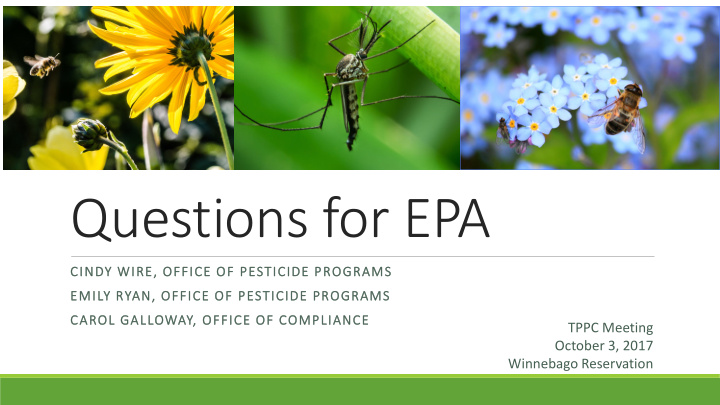



Questions for EPA CINDY Y WIRE, O OFFICE O OF PESTICIDE P PROGR GRAMS EMILY R Y RYAN, O OFFICE O OF PESTICIDE P PRO ROGR GRAMS CAROL G L GALL LLOWAY, OFFICE O OF COMPLI PLIANCE E TPPC Meeting October 3, 2017 Winnebago Reservation
Questions for EPA 1. Discuss the Fiscal Year (FY) 2018 and 2019 budget. How can we comment adequately on FY 2019 when we don’t even know what FY 2018 is? Fiscal Year 2018: Continuing Resolution signed last week through December 8th; FY17 enacted levels; no specifics yet on budget for rest of FY18. Have requested full tribal STAG funding from OPP. In the process of funding TPPC for FY18. Fiscal year 2019: In the initial stages of development; president’s budget will be released in February 2018. Built on FY18 president’s budget. NTC included pesticide information as one of their top funding priorities. NTC meeting with EPA next week 2
National Tribal Caucus Priorities for FY19 Top FY 2019 Budget Priorities • Maintain funding for state, local, and tribal air quality programs. • Sustain tribal funding under the Clean Water Act. • Provide sufficient funding for tribes to conduct toxics monitoring, risk assessments, and biomonitoring studies on toxics and tribal communities. • Preserve funds for tribal pesticide programs and support tribal efforts on integrated pest management in public housing, pesticide risk assessments, and pollinator protection. • Support sustainable and ongoing tribal waste operations and pollution prevention solutions. • Restore funding to the Exchange Network (EN) and determine how to support operation and maintenance costs under EN grants. 3
Questions for EPA 2. Provide information on genetically Modified (GM) mosquitos or other new developments. Shifting from a School IPM focus to Integrated Vector Management Focusing on public health issues such as Zika. EPA Center for Integrated Pest Management taking the lead. Debug Project: Experimental Use Permit issued to Google Verily to release bacteria- infected male mosquitos in Fresno, CA. Wolbachia bacteria infected male mosquitos mate resulting in non-viable eggs. Over time this will drive down the Aedea aegypti population. This bacteria doesn’t affect humans. Could be registered as a pesticide eventually. FDA Experimental Use Permit to Oxitec for GM mosquitos in Florida 4
Questions for EPA 3. New 2, 4-D formulations- Updates/ any problems seen yet? The 2,4-D choline “Enlist” formulations for 2,4-D tolerant crops (Enlist Duo and Enlist One) were registered in October 2015 (Enlist Duo) and January 2017 (Enlist One). These “Enlist” formulations have lower volatility, and both are currently available in the marketplace. The Registration Division of OPP has not received any reports of field damage related to these products this year. 2,4-D is currently undergoing registration review. The risk assessments for 2,4-D were published in June 2017, followed by a 60-day comment period. The proposed interim decision is scheduled to be published in June 2018, and will also be followed by a 60-day comment period. 5
Questions for EPA 4. Are there small grants available to tribes for pollinator habitat enhancement, or to start a honey production services and products business? This is a list of federal grants available from different federal agencies on the TPPC Website http://tppcwebsite.org/sources-for-grants/ Northeastern IPM Center http://www.northeastipm.org/grant-programs/ipm-center-grants/ Western IPM Center http://westernipm.org/index.cfm/center-grants/ North Central IPM Center https://www.ncipmc.org/grants/index.php Southern IPM Center http://www.sripmc.org/index.cfm/center-projects/grant-programs/ 6
Questions for EPA 5. OECA’s status for Increased enforcement presence in Indian Country – FY16 National Program Managers’ Guidance established priority on direct implementation of WPS compliance monitoring in Indian Country Regions committed to conducting 16 WPS inspections and instead conducted 25 inspections (Regions must conduct 10 FIFRA inspections each year) Took different forms across the country, for example, in Region 1 ME conducted an oversight inspection, under an agreement between the state and tribe, at the Passamaquoddy Wild Blueberry Co. 7
Questions for EPA 5. OECA’s status for Increased enforcement presence in Indian Country – continued Region 4 started dialogue with tribes on WPS, found minor violations at a Choctaw facility, and did WPS training for tribes Region 8 issued 12 Notices of Warning (inspected 13 facilities), and Region 10 conducted 3 training inspections for a new inspector. Results not in for FY17, however, R4 planned to conduct 2-3 additional inspections, R9 planned to conduct 6 inspections In FY16, tribes conducted 123 WPS inspections OECA welcomes comments on the initiative 8
Questions for EPA 6. What is the cannabis situation on reservations/ federal lands? Can tribes establish grow operations and use pesticides legally? 7. Does EPA have any plans for protecting tribes from illegal use of pesticides on cannabis on tribal lands? Marijuana remains a schedule 1 controlled substance under the Controlled Substances Act. Therefore, the EPA has not registered any pesticide for use on marijuana. 9
Recommend
More recommend